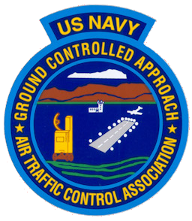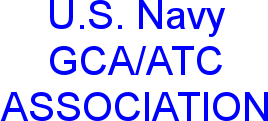The first Navy control tower opened on 30 June 1938 at NAS San Diego, now known as NAS North Island. Two Radiomen initially staffed the facility. An Aviation Machinist Mate was added as a TAD assignment in 1944. These initial individuals who performed air traffic control tasks were trained at the Civil Aeronautics Administration (CAA) schools or on-the-job.
On 6 March 1943, the rating of Specialist (T) (Teacher) (Control Tower Operator) was established primarily for USNR Class V-10 Women Accepted for Voluntary Emergency Service (WAVES). In June 1943, the Navy established an air traffic control school in Forth Worth, Texas. On 12 October 1943, the Spec (T) (Teacher) (Control Tower Operator) rating was changed to the Specialist (Y) (Control Tower Operator) rating. After six months in Fort Worth, in December 1943, the school was moved to NAS Atlanta, Georgia where it remained for over two years.
During this same period, Dr. Louis Alvarez, a pilot, physicist, and antenna radiation expert at the Massachusetts Institute of Technology (MIT), was refining the newly invented precision radar. Dr. Alvarez envisioned using the same type precision radar that was used to play search lights and direct anti-aircraft and shipboard gunnery, to determine the azimuth and elevation position of an aircraft in relation to an "ideal" flight path.
The laboratory model of this ground controlled approach (GCA) system was developed at the Radiation Laboratory at MIT and was successfully field-tested by Navy operational personnel in May 1943. Shortly thereafter, the Chief of Naval Operations approved GCA as the standard talk-down approach control system and field training of GCA crews commenced at Gainesville, Georgia (approximately 50 miles northeast of Atlanta). This school was moved to Banana River, Florida in 1945. In an eight-week course, personnel of the Spec "Y", Quartermaster, and Radarman ratings received training using the MPN-1 radar and SNB aircraft. Each student made approximately 150 actual approaches ("live runs").
On 29 April 1946, the basic air traffic control school called the Spec "Y" School, moved from Atlanta, Georgia to Jacksonville, Florida.
With the end of World War Two, the Navy in 1946 moved the GCA school with an Officer-in-Charge to NAS Olathe, Kansas (just southwest of Kansas City). The GCA "C" School was increased to 12 weeks and later reduced to 10 weeks. GCA trainees conducted 150 - 200 "live runs" using the MPN-1, CPN-4, and MPN-5 radars. SNB and T-34 aircraft provided flight services. In addition, GCA maintenance courses provided training for Electronics Technicians (ET) and Engineman (EN). In November 1947, the basic air traffic control school was moved to NAS Olathe. Effective 2 April 1948, under the post World War Two Rating Revision Program, the rating of Air Controlman, abbreviated AC, was established at the four Petty Officer grades of Chief, First Class, Second Class and Third Class. In 1948, the GCA "C" School and the AC "A" School were united in one organization with the commissioning of the Naval Air Technical Training Unit (NATTU) Olathe. Early in 1953, an advanced school (AC "B" School) was added to the program conducted at NATTU Olathe. In 1955, a 15-W-15 Carrier Controlled Approach (CCA) trainer was installed and the CCA "C" and "O" (Officer) courses were established. In 1956, an Air Traffic Control Officers Course (Class "O") was established to train Naval Aviators and Aviation Ground Officers to serve as Air Traffic Control Officers at Naval Air Stations, Officers-in-Charge of GCA Units, and Radar Air Traffic Control Center (RATCC) Officers and Watch Officers.
In 1958 with the passage of the Federal Aviation Act, all military air traffic controllers were required to be licensed and certified by the Federal Aviation Agency and military air traffic control was brought under the cognizance of the National Airspace System. The Navy's air traffic control schools remained at NATTU Olathe until March 1962 at which time 11 courses were moved to form the Air Traffic Control Schools Division of Naval Air Technical Training Center (NATTC), NAS Glynco, Georgia.
At Glynco, the Air Controlman "A" School initially occupied one of the few remaining wooden blimp hangars in the United States. The GCA course initially occupied the "T" Building with "live runs" conducted from the Pelican GCA and Acky GCA CPN-4 complexes at the old NAS Glynco mat area. At the 10-week GCA course, using the MPN-5 radar for "synthetic" training and the CPN-4 for "live" training, each student made 150 "live runs." The course was reduced to 8 weeks and subsequently to 5.5 weeks. After the course was reduced to 5.5. weeks, students made approximately 200 "synthetic runs" and 55 "live runs" using S-2 aircraft. Students also received "flight skins" and flew in the right seat of the S-2 while listening/observing the pilot conduct GCA approaches under the guidance of Pelican and Acky GCA "student controllers."
In 1970, the Air Controlman "A", "B", and "O" schools moved from the blimp hangar into a new, modern Applied Instruction Building. On 1 February 1971, all facilities of the GCA "C" School (with the exception of the Pelican and Acky GCA complexes) moved from the "T" Building to the new Air Traffic Control School Building. The CCA "C" and "O" courses as well as Team Training remained at the "T" Building.
In April 1973, the Department of Defense announced that several bases and stations within the Continental United States were to be closed. Among those listed was NAS Glynco. The Air Traffic Control Operations and Maintenance Schools were to be relocated to NATTC Millington, NAS Memphis in western Tennessee. In June 1973, the architectural and engineering contract for the new school building (MILCON P-999) at NATTC Millington was awarded to a Memphis-based firm. An inspection of available NATTC Millington facilities suitable for the interim location of the ATC schools was conducted in October 1973. In November 1973, Buildings S-54 and S-55 (World War Two vintage wooden structures) were designated by the Chief of Naval Technical Training for the ATC Operations Schools and Building S-103 was designated for the ATC Maintenance Schools. On 28 February 1974, the construction contract and notice to proceed on MILCON P-999 were issued. Site work began on 2 April 1974, with the official ground breaking on 24 May 1974. NAS Memphis Public Works Department began the rehab of Buildings S-54 and S-55, and on 7 July 1974 these buildings were accepted from Public Works and Navy Self-Help established for rehab completion. The ATC School Advance Party arrived from Glynco on 12 August 1974 to begin preparations for the convening of the first AC (A1) class scheduled for September. A few days later, the first shipment of training materials and related equipment arrived from Glynco. On 18 September, Building S-103 was accepted from Public Works by the ATC Maintenance School. The following day, additional training aids and equipment arrived from Glynco.
The year 1974 also brought extensive changes to U.S. Navy air traffic control training. As a result of the Naval Occupational Task Analysis Program (NOTAP) survey of the Air Controlman rating, more emphasis was to be placed on "hands-on" laboratory training. The survey also recognized that radar had become a basic element of air traffic control and thus, radar procedures should be taught at the "A" school level.
Significant 1974 events:
- March 1974 - Hydrosystems Training Device 15G14 installed for use in radar training.
- 18 March 1974 - The first AC "A" class (#442) started the new Block I two-week Aviation Fundamentals/Basic ATC Indoctrination/Control Tower Operator (CTO) self-paced program.
- 26 April 1974 - The first AC "A" class started the new 14-week curriculum (includes radar training).
- 30 April 1974 - Last S-2 ("live runs") flights for GCA training, ending a concept started in 1944. Over 290, 000 approaches were made since training commenced at NATTC Glynco. Radar training will now be "simulated."
- 1 July 1974 - GCA "C" School redesignated as Block IV of AC "A" School.
- 23 September 1974 - The last AC "A" class (#513) started training at NATTC Glynco.
- 30 September 1974 - The first AC "A" class (#514) started training at NATTC Millington.
- 20 December 1974 - The last AC "A" class (#513) graduated at NATTC Glynco, ending 12 years of air traffic control training at NATTC Glynco.
During the Glynco-to-Millington transition, Carrier Air Traffic Control Center (CATCC) training was conducted at the West Coast Team Training site at Fleet Combat Direction Systems Training Center (FCDSTC) Pacific, San Diego (Point Loma). CATCC operator training continued here through early 1976 until classroom/labs were in place in the new ATC School Building, NATTC Millington.
On 14 May 1976, the new Air Traffic Control Educational Facility (Building S-769) at NATTC Millington, a 3.9 million dollar construction project, was opened and dedicated as Wood Hall. This facility became the new home for Navy, Marine Corps, and Coast Guard air traffic control operators and maintenance technicians. Captain Robert H. Wood, U.S. Navy (Retired) was a pioneer in the development of the GCA system for the Navy in 1943, and piloted the first all-weather flights using the system for which he received the Air Medal. Later, he held a succession of command and staff positions including Commanding Officer, NATTC Millington and Chief of Staff, Chief of Naval Technical Training at the time of his retirement in 1968. Captain Wood was serving as Director of Memphis International Airport at the time of his death in 1975. RADM A.M. Sackett, Chief of Naval Technical Training; CAPT J.L. Gerard, Commanding Officer NATTC Millington; and CDR Chuck Riley, ATC Schools Officer in Charge conducted the dedication ceremony. Also present was Mrs. Robert H. Wood.
In 1990, the Defense Base Realignment and Closure (BRAC) Act created special commissions to review Department of Defense installations for disestablishment or reorganization. The 1993 commission recommended NATTC Millington be realigned to NAS Pensacola, Florida. Thus, it became necessary to move the Navy's air traffic control school once again. Planning and budgeting for the move began in 1994. Ground breaking for the new NATTC Pensacola took place at the former Naval Aviation Depot (NADEP) at Chevalier Field, NAS Pensacola on 14 February 1995. The Air Traffic Control School was to be located in an existing building (Building 3220), a former NADEP avionics maintenance building. The first NATTC Millington Training Department to move to the new Pensacola complex, the ATC Training Department, completed the move in March 1996. On 1 April 1996, a ribbon cutting ceremony was conducted and training started that day. In attendance at the ribbon cutting ceremony were: VADM Timothy W. Wright, Chief of Naval Education and Training; Joe Scarborough, Congressman 1st Congressional District of Florida; John Fogg, Mayor of Pensacola; CAPT Timothy Thomson, Commanding Officer NAS Pensacola; 1988.
Commanding Officer NATTC Millington/Pensacola; and CDR David W. Kelch, Officer in Charge, ATC Training Department. On 18 October 1996, the Air Traffic Control School located at NATTC Pensacola, Building 3220 was dedicated as Calhoun Hall. Captain Jimmy R. Calhoun, U.S. Navy (Retired) served as a Navy Air Traffic Controller for over 39 years, from June 1956 until his retirement in September 1995. Calhoun Hall recognizes Captain Calhoun's career long contributions to the U. S. Navy and to the Air Traffic Control profession. His reputation for excellence has been recognized by three separate awards from the world wide Air Traffic Controllers Association, one of which honored him as the individual making the greatest contribution to the field of Air Traffic Control in 1988.



